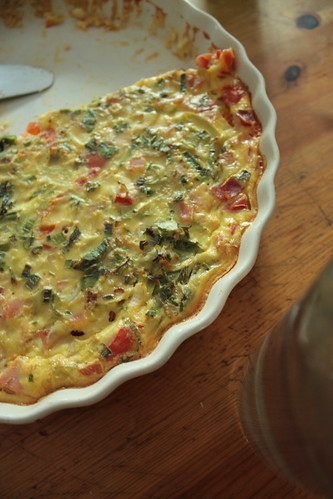C'est un classique familial. Chez nous, on l'appelle "quiche Catherine", souvenir d'une Catherine depuis longtemps perdue de vue, qui est je suppose à l'origine de la recette. C'est la plat parfait pour une entrée ou un plat unique quand on est à la bourre, en panne d'imagination, ou avec de petits restes.
This recipe is a family classic. We use to call it "quiche Catherine", after a Catherine we've long lost contact with. It's a really simple, really basic dish, it can be either an entrée or a main course, it's perfect for a tired weekday evening as well as for using up those small leftovers in the fridge.

Quiche Catherine
5 oeufs - 5 eggs
3 petits verres de lait d'avoine - 3 cups oat milk
3 grosses cuillères à soupe de farine - 3 (large) tblsp all-purpose flour
1 paquet de lardons - a few bacon slices
1 poivron vert - 1 green bell pepper
1 poivron rouge - 1 red bell pepper
1 oignon - 1 onion
Préchauffez votre four à 180°C.
Dans une poêle, faites revenir les lardons. Ajoutez très rapidement les oignons émincés et les poivrons coupés en petits cubes. Laissez dorer les lardons et fondre l'oignon.
Pendant ce temps, battez dans une jatte les oeufs avec la farine. Ajoutez doucement (sinon ça va faire des grumeaux) le lait d'avoine.
Graissez un poule à tarte, étalez dedans la garniture, puis versez la pâte par-dessus.
Enfourner 30 à 40 minutes, jusqu'à ce que le dessus commence à dorer.
Preheat your oven at 360°F.
Cut the bacon slices in smallish bits, put them in a hot pan, adding the minced onion and diced peppers as soon as there's a little grease in the pan. Cook until the bacon is golden and the onion soft.
In a mixing bowl beat the whole eggs with the flour, slowly add the oat milk.
Grease your mold (the flatter the mold, the better), transfer the bacon and vegetables into it. Pour the batter over them.
Bake for 30 to 40 minutes - until the top gets slightly golden.
Ce qu'il y a de merveilleux avec les quiches, c'est qu'on peut les faire à tout. Un reste de courgettes sautées ? Du saumon fumé ? Des épinards ? Un bout de fromage un peu trop "caractériel" ? Ca y va !
Ce qu'il y a de merveilleux avec ce plat, c'est qu'on n'a même pas besoin de faire de pâte (mais riend ne vous empêche d'en faire une, ou de prendre un pâte feuilletée du commerce, c'est bon aussi), du coup, c'est vraiment très, très rapide à préparer.
Now the great thing aoubt quiche is that you can just put about anything into it. Leftover sautéed zucchinis ? smoked salmon ? Spinach ? Goat cheese ? It all goes in !
And the other great thing about this one it you don't even have to make a proper pie crust - of course, you can make one, it you really want to, or use a ready-made puff pastry dough, it works really well, too.
Préchauffez votre four à 180°C.
Dans une poêle, faites revenir les lardons. Ajoutez très rapidement les oignons émincés et les poivrons coupés en petits cubes. Laissez dorer les lardons et fondre l'oignon.
Pendant ce temps, battez dans une jatte les oeufs avec la farine. Ajoutez doucement (sinon ça va faire des grumeaux) le lait d'avoine.
Graissez un poule à tarte, étalez dedans la garniture, puis versez la pâte par-dessus.
Enfourner 30 à 40 minutes, jusqu'à ce que le dessus commence à dorer.
Preheat your oven at 360°F.
Cut the bacon slices in smallish bits, put them in a hot pan, adding the minced onion and diced peppers as soon as there's a little grease in the pan. Cook until the bacon is golden and the onion soft.
In a mixing bowl beat the whole eggs with the flour, slowly add the oat milk.
Grease your mold (the flatter the mold, the better), transfer the bacon and vegetables into it. Pour the batter over them.
Bake for 30 to 40 minutes - until the top gets slightly golden.
Ce qu'il y a de merveilleux avec les quiches, c'est qu'on peut les faire à tout. Un reste de courgettes sautées ? Du saumon fumé ? Des épinards ? Un bout de fromage un peu trop "caractériel" ? Ca y va !
Ce qu'il y a de merveilleux avec ce plat, c'est qu'on n'a même pas besoin de faire de pâte (mais riend ne vous empêche d'en faire une, ou de prendre un pâte feuilletée du commerce, c'est bon aussi), du coup, c'est vraiment très, très rapide à préparer.
Now the great thing aoubt quiche is that you can just put about anything into it. Leftover sautéed zucchinis ? smoked salmon ? Spinach ? Goat cheese ? It all goes in !
And the other great thing about this one it you don't even have to make a proper pie crust - of course, you can make one, it you really want to, or use a ready-made puff pastry dough, it works really well, too.